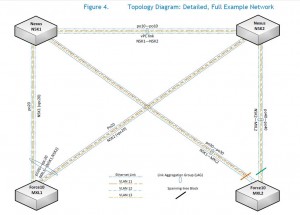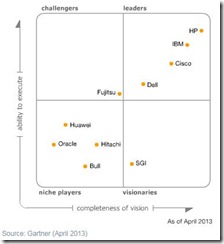The Intel Xeon E7 v2 CPU was officially announced today advertising 2x the performance, 3x the memory and 4x the I/O bandwidth compared to previous generations. For more information on what the E7 v2 CPU offers, as well as what blade servers were announced, continue reading below.
Category Archives: Cisco
Comparison of x86 Blade Servers
(UPDATED 11.5.2013) I often find myself seeking basic information for competitive blade servers, so I decided to sit down and put together a basic list of blade server details for Cisco, Dell, HP and IBM blade servers. The details provided are based on information publicly available and may be subject to errors. Continue reading
Max Ethernet Connections on 2 Socket Blade Servers
As 10GbE storage connectivity becomes more popular, the number of 10GbE connections you can get on a blade server becomes a consideration. In this blog post, I’ll review the offerings each blade vendor has to help you easily decide which works best for your project.
IDC Worldwide Server Tracker for Q1 2013
IDC came out with their Q1 2013 worldwide server market revenue report on May 29, 2013 which shows blade server revenues decreased 2.9% year over year to $1.9 billion while accounting for 17.7% of all server revenues reported. According to the report, this is the fifth time in the previous six quarters that the server market has experienced a year-over-year decline in worldwide revenue. Server unit shipments decreased 3.9% year over year in 1Q13 to 1.9 million units as consolidation continued to be a strategic focus for many large and small customers around the globe. Continue reading
Gartner Blade Server Quadrant (April 2013)
Gartner released the annual Magic Quadrant for blade servers last month and it shows significant changes across the leaderboard within the top 4 leading blade server vendors.
The Magic Quadrant is a tool Gartner uses to visually define a given market segment showcasing technology vendors who are leading the market in 4 areas:
Blade Server Networking Options
If you are new to blade servers, you may find there are quite a few options to consider in regards to managing your Ethernet traffic. Some vendors promote the traditional integrated switching, while others promote extending the fabric to a Top of Rack (ToR) device. Each method has its own benefits, so let me explain what those are. Before I get started, although I work for Dell, this blog post is designed to be an un-biased review of the network options available for many blade server vendors.
IDC Worldwide Quarterly Server Tracker – Q4 2012 Results
IDC released their Q4 server numbers on Wednesday. Here is a quick summary of the findings – for a full summary, read the full report via the link at the bottom.
Best Practices for Using the Dell Force10 MXL in Cisco Nexus Environments
One of the best offerings that Dell has within their blade server I/O portfolio is the Dell Force10 10/40 GbE MXL Switch Module. You can check out the full details on my earlier blog post, but at a high level, this switch provides 32 x 10GbE ports downstream to the blade servers while offering up to 6 x 40GbE ports up stream. In addition, up to (6) MXL switch IOMs can be stacked using ring or daisy-chain topology giving it a stacking bandwidth upstream of 320G all while providing intra-chassis communication allowing servers to talk to each other without going out to the Access layer. But, if you have a Cisco network, will this work? Believe it or not, Dell and Cisco can play nice together.
The engineers at Dell recently released an easy-to-use guide of recommended basic deployment practices for the Dell Force10 MXL in the access layer of a Cisco Nexus network environment. I have to warn you though – it’s not for the faint at heart, as it includes detailed command line verbage on how to set it up. If you know what the command ” # feature enable vpc” does within NX-OS, you’ll appreciate this document. The guide is broken up topically as follows:
- the and concepts of MXL switch deployment
- introduction to the Force10 MXL hardware and its connectivity and management options
- the first steps of MXL deployment (including a rapid introduction to some common MXL initial deployment tasks)
- downlink (server-side) configuration options
- Link Aggregation Group Configuration
- Uplink configuration options to the Cisco Nexus network environment: running PVST with discreet LAGs nd running PVST with a single LAG connected across two top-of-rack switches that are using a Multi-chassis LAG
 If you have a Cisco Nexus network, take a few minutes to see how easy it is to add a Dell Force10 MXL into your environment. You might just be surprised at what you find.
If you have a Cisco Nexus network, take a few minutes to see how easy it is to add a Dell Force10 MXL into your environment. You might just be surprised at what you find.
Download the complete whitepaper titled, “Deploying the Dell Force10 MXL into a Cisco Nexus Network Environment” at http://bit.ly/DellMXLonNexus
Kevin Houston is the founder and Editor-in-Chief of BladesMadeSimple.com. He has over 15 years of experience in the x86 server marketplace. Since 1997 Kevin has worked at several resellers in the Atlanta area, and has a vast array of competitive x86 server knowledge and certifications as well as an in-depth understanding of VMware and Citrix virtualization. Kevin works for Dell as a Server Sales Engineer covering the Global 500 market.
Disclaimer: The views presented in this blog are personal views and may or may not reflect any of the contributors’ employer’s positions. Furthermore, the content is not reviewed, approved or published by any employer.
IDC Worldwide Server Tracker for Q2 2012 Shows Blades Continue to Grow
IDC came out with their Q2 2012 worldwide server market revenue report on August 28, 2012 which shows that a 4.3% drop in server revenues worldwide, marking the third straight quarter of decline. Continue reading
IDC Q1 2012 Server Report Shows Blade Server Sales Continue to Increase
IDC came out with their Q1 2012 worldwide server market revenue report on May 30, 2012 which shows that in spite of a decrease in overall server sales worldwide, blade server revenues increased 7.3% year over year.
